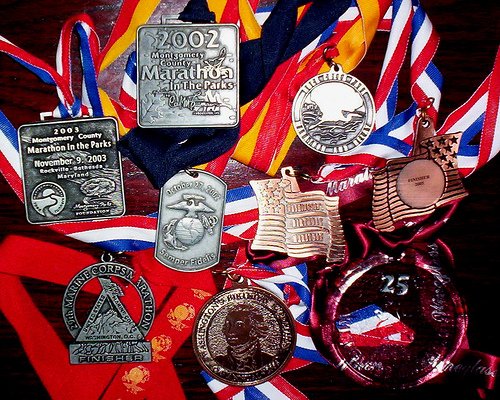Are you hoping to qualify for the Boston Marathon?
Maybe you’re trying to run another personal record at the Chicago Marathon. Whatever your marathon goals, I have several strategies for your marathon workouts that will take your training to the next level.

The marathon doesn’t have to be so intimidating. With the right training, and the right marathon workouts, you can be much closer to accomplishing your goals. There are several ways to get the most out of your marathon training. Some of these tips won’t take any extra time to execute.
First, I want to explain my marathon training philosophy to put these suggestions in context. I want you to understand how I tackle the marathon and why these strategies will make you faster.
What Type of Marathon Workouts Did I Run?
It’s important to understand that racing the marathon is entirely aerobic. It requires no anaerobic work; your heart and breathing rate will stay well below your maximum for the entire race. Research has indicated that the marathon (and the half-marathon also) is 99% aerobic and 1% anaerobic.
If you broke the marathon down into 1% segments, the portion of the race that’s anaerobic is only a shade over 400 meters. So if you qualify for Boston, that’s only the time you’re on Boylston Street! Your training time is best served preparing for the other 99% of the race.
This means that for marathon runners, speed development is not done with classic interval workouts. Especially for new and even intermediate runners, there is no need to run fast track workouts for the marathon. This goes contrary to popular belief as many runners want to improve their speed over the distance.
But to improve speed over 26.2 miles, you have to increase endurance. If you can run a 4:30 marathon, that’s an average of about 10:20 per mile. An ambitious goal would be to break 4 hours – or run closer to 9 minutes per mile. This level of improvement requires only aerobic conditioning.
This principle applies to faster runners too. I ran the 2008 NY Marathon in 2:44 and did virtually no anaerobic (or fast intervals) workouts prior to the race. I did three key workouts every week for the two months leading up to the race:
- A long run with several miles at the end at marathon pace.
- A medium-long run with 5 miles at marathon pace in the middle.
- A (slightly longer) medium-long run with 6-7 miles at marathon pace, negative splitting to my tempo pace.
These are the only workouts I did, except for one slightly faster track workout two weeks before the race. In hindsight, I wouldn’t do that again.
My goals were simple: make marathon pace as comfortable as possible and develop as much aerobic capacity as I could. By the end of my hard training block, my long run was 22 miles with 6 miles at 5:50 pace at the end. I ran 13 miles with 5 at 5:50 pace. My other workout was 15 miles with a 7 mile tempo starting at 6 minute pace and ending at about 5:30 pace.
The training sounds intense, but none of it was very fast. Every time I laced up my shoes, I wasn’t even approaching my red-line speed or heart rate. Investments in aerobic capacity are small deposits that pay large dividends later. On the other hand, fast interval-based workouts are like quick paydays that you have to spend soon. They don’t last.
What Type of Marathon Workouts Should You Run?
You should do the same type of workouts that I did! Depending upon your experience and fitness level, you might run more than me or faster than me. But the principles remain the same – build your aerobic base as large as possible.
There are 5 key workouts and types of training that you should focus on as you prepare for your marathon. All of them develop leg strength, endurance, and will help you run faster for longer.
The Long Run: Aim to run at least 20 miles before your marathon. If you have months before your marathon, run more 20 mile runs (a 20 miler every week for a month is better than just one!). When I was training, I wanted to err on the side of too long so I went with 22 miles. Only run what you’re ready to handle!
- Aerobic Bonus: At the end of your long run, do a few miles at marathon pace. Not only are you recruiting more muscle fibers in a fatigued state, but you’re mentally preparing your body to run fast when it’s tired. Alternatively, run long hill climbs of 10-15 minutes or hilly terrain at the end of your long run. I call these “rollercoaster runs.”
Run More Mileage: It’s so simple! Run more, get faster. For the marathon, you don’t have to run fast. Just run more volume. The enhanced aerobic stimulus of an extra 10-20% bump in weekly mileage will make you a much better runner. I advise all of my athletes to replace interval workouts with more mileage when they’re training for a half-marathon or marathon.
- Aerobic Bonus: Be selective about how you run more. I typically run a 5 mile easy run every week. Bumping that run to 7 miles isn’t as useful to my fitness level as bumping my 17 mile long run to 19 miles. It’s still only 2 miles, but where that 2 miles happens is important. Increase your long run, second longest run, etc. for the most benefit. Running more on workout days is another added bonus to your aerobic capacity.
Marathon Pace and Tempo Workouts: These two workouts should be the only type of marathon workouts you do. Marathon pace (MP) workouts – either repetitions or a single run – get you used to the pace you’re going to run on race day. It’s vital that you’re comfortable with this pace. Tempo workouts are faster (but still aerobic) and provide support to your MP. They’ll make MP easier, both physically and mentally.
- Aerobic Bonus: After a warm-up, do a long continuous run (I did 6-7 miles) starting at MP progressing to tempo pace. For me, this was starting at 6 minute pace and then negative-splitting the workout to about 5:30 per mile. This type of workout helped me get in great shape for the 2008 NY Marathon.
At the end of the day, you’re going to be running very similar workouts to everybody else training for the marathon.

You’ll have your long runs, your regular distance runs, and your tempo/marathon pace workouts. But what’s going to help you beat your training buddy is how you run these workouts.
Did you negative split your marathon pace workout ending at tempo pace? Did you climb a 12 minute hill at the end of all of your long runs? Did you skip the weekly 1,000m intervals and instead run an extra 8 miles every week?
Small decisions made every few days over the course of a 2-3 month training block can provide big gains in fitness. Especially when it comes to marathon workouts and their potential to dramatically increase your endurance and turn you into an aerobic powerhouse.
Are you looking to run a fast marathon? See all of our training programs to help you level up your running!
Photo Credit: Zach Klein and zhurnaly